Report: Impact of Organizational Factors on Budgetary Slack Analysis
VerifiedAdded on 2020/05/28
|5
|1452
|49
Report
AI Summary
This report examines the impact of organizational factors on budgetary slack within organizations, particularly in Australia. It defines budgetary slack as the intentional underestimation of revenue and overestimation of expenses, often driven by managers' self-interest in performance evaluations and rewards. The report explores the role of budgetary slack in the context of planning, coordination, and resource control. Key organizational factors such as budget participation, budget emphasis, and information asymmetry are analyzed for their influence on the creation of slack. High levels of participation and budget emphasis, along with asymmetric information flow, are identified as contributors to increased budgetary slack. The report concludes with recommendations for mitigating budgetary slack, including fostering open communication, promoting ethical behavior, and minimizing reliance on budget as a negative control tool.
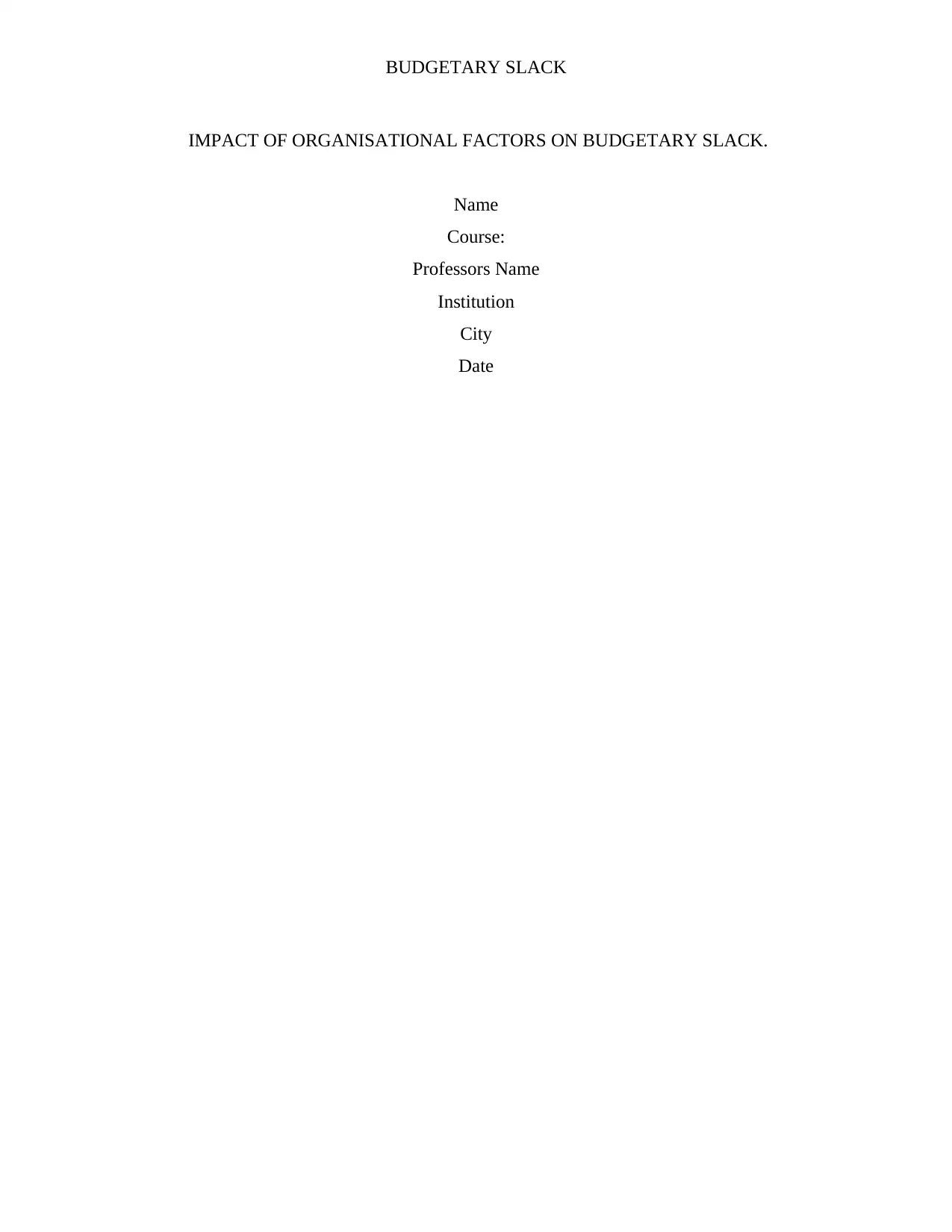
BUDGETARY SLACK
IMPACT OF ORGANISATIONAL FACTORS ON BUDGETARY SLACK.
Name
Course:
Professors Name
Institution
City
Date
IMPACT OF ORGANISATIONAL FACTORS ON BUDGETARY SLACK.
Name
Course:
Professors Name
Institution
City
Date
Paraphrase This Document
Need a fresh take? Get an instant paraphrase of this document with our AI Paraphraser
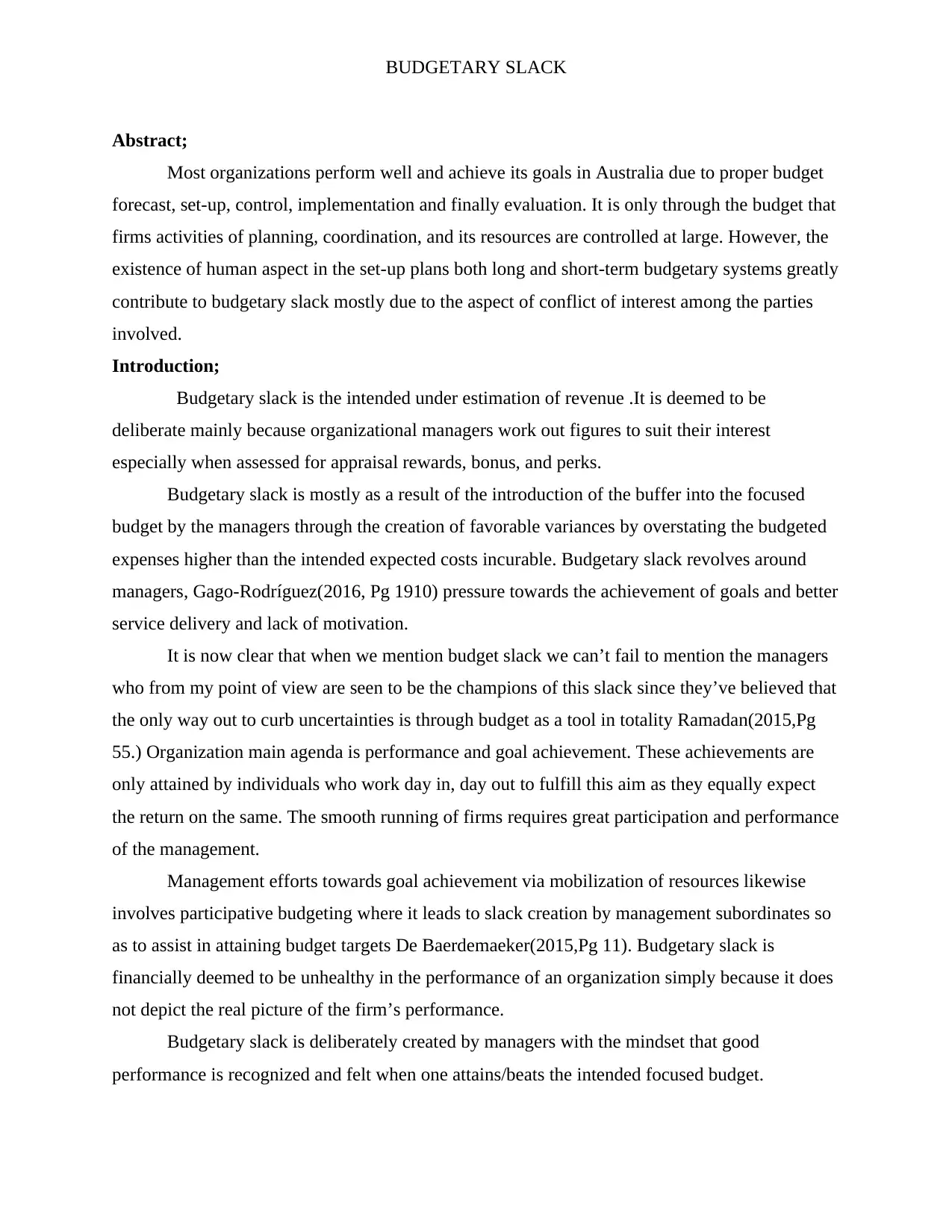
BUDGETARY SLACK
Abstract;
Most organizations perform well and achieve its goals in Australia due to proper budget
forecast, set-up, control, implementation and finally evaluation. It is only through the budget that
firms activities of planning, coordination, and its resources are controlled at large. However, the
existence of human aspect in the set-up plans both long and short-term budgetary systems greatly
contribute to budgetary slack mostly due to the aspect of conflict of interest among the parties
involved.
Introduction;
Budgetary slack is the intended under estimation of revenue .It is deemed to be
deliberate mainly because organizational managers work out figures to suit their interest
especially when assessed for appraisal rewards, bonus, and perks.
Budgetary slack is mostly as a result of the introduction of the buffer into the focused
budget by the managers through the creation of favorable variances by overstating the budgeted
expenses higher than the intended expected costs incurable. Budgetary slack revolves around
managers, Gago-Rodríguez(2016, Pg 1910) pressure towards the achievement of goals and better
service delivery and lack of motivation.
It is now clear that when we mention budget slack we can’t fail to mention the managers
who from my point of view are seen to be the champions of this slack since they’ve believed that
the only way out to curb uncertainties is through budget as a tool in totality Ramadan(2015,Pg
55.) Organization main agenda is performance and goal achievement. These achievements are
only attained by individuals who work day in, day out to fulfill this aim as they equally expect
the return on the same. The smooth running of firms requires great participation and performance
of the management.
Management efforts towards goal achievement via mobilization of resources likewise
involves participative budgeting where it leads to slack creation by management subordinates so
as to assist in attaining budget targets De Baerdemaeker(2015,Pg 11). Budgetary slack is
financially deemed to be unhealthy in the performance of an organization simply because it does
not depict the real picture of the firm’s performance.
Budgetary slack is deliberately created by managers with the mindset that good
performance is recognized and felt when one attains/beats the intended focused budget.
Abstract;
Most organizations perform well and achieve its goals in Australia due to proper budget
forecast, set-up, control, implementation and finally evaluation. It is only through the budget that
firms activities of planning, coordination, and its resources are controlled at large. However, the
existence of human aspect in the set-up plans both long and short-term budgetary systems greatly
contribute to budgetary slack mostly due to the aspect of conflict of interest among the parties
involved.
Introduction;
Budgetary slack is the intended under estimation of revenue .It is deemed to be
deliberate mainly because organizational managers work out figures to suit their interest
especially when assessed for appraisal rewards, bonus, and perks.
Budgetary slack is mostly as a result of the introduction of the buffer into the focused
budget by the managers through the creation of favorable variances by overstating the budgeted
expenses higher than the intended expected costs incurable. Budgetary slack revolves around
managers, Gago-Rodríguez(2016, Pg 1910) pressure towards the achievement of goals and better
service delivery and lack of motivation.
It is now clear that when we mention budget slack we can’t fail to mention the managers
who from my point of view are seen to be the champions of this slack since they’ve believed that
the only way out to curb uncertainties is through budget as a tool in totality Ramadan(2015,Pg
55.) Organization main agenda is performance and goal achievement. These achievements are
only attained by individuals who work day in, day out to fulfill this aim as they equally expect
the return on the same. The smooth running of firms requires great participation and performance
of the management.
Management efforts towards goal achievement via mobilization of resources likewise
involves participative budgeting where it leads to slack creation by management subordinates so
as to assist in attaining budget targets De Baerdemaeker(2015,Pg 11). Budgetary slack is
financially deemed to be unhealthy in the performance of an organization simply because it does
not depict the real picture of the firm’s performance.
Budgetary slack is deliberately created by managers with the mindset that good
performance is recognized and felt when one attains/beats the intended focused budget.
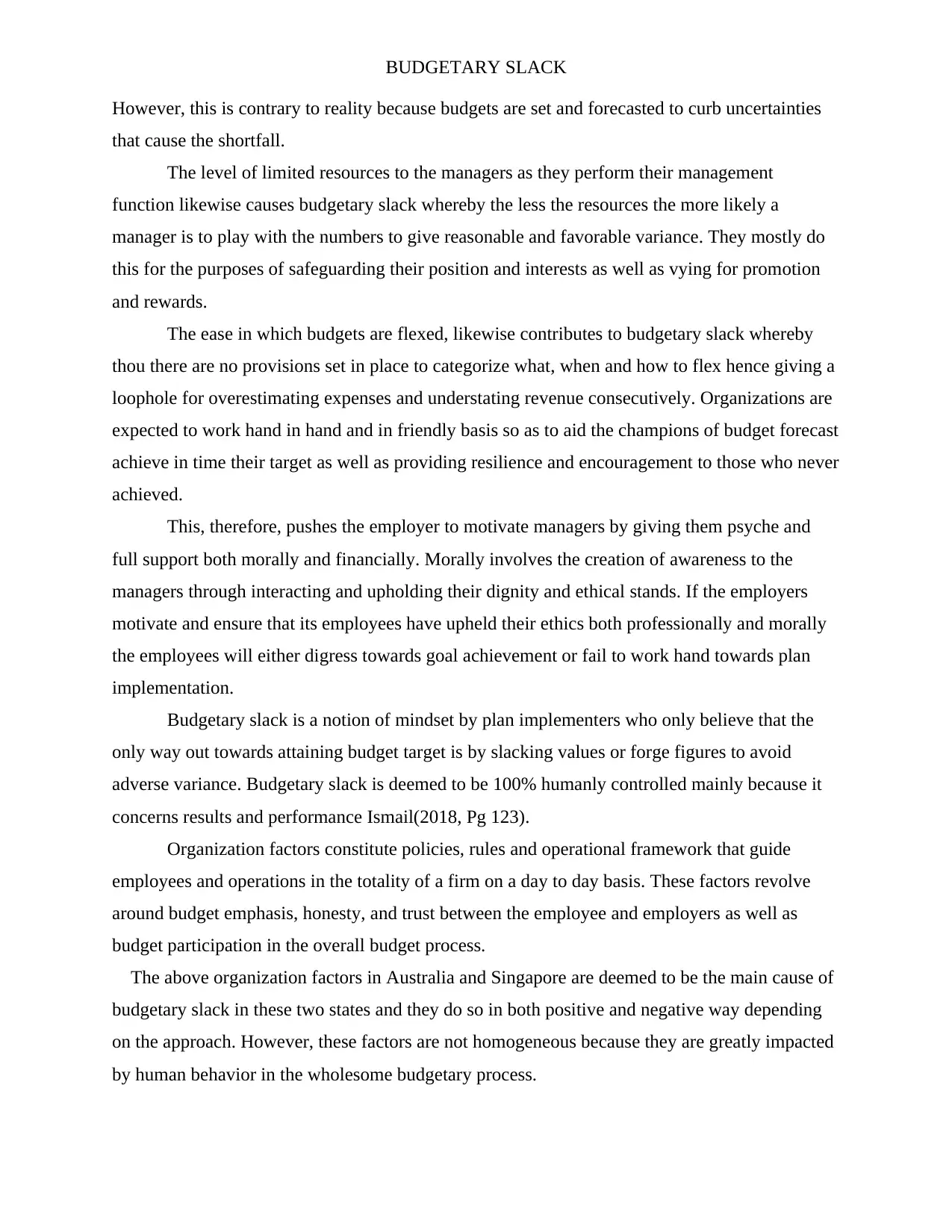
BUDGETARY SLACK
However, this is contrary to reality because budgets are set and forecasted to curb uncertainties
that cause the shortfall.
The level of limited resources to the managers as they perform their management
function likewise causes budgetary slack whereby the less the resources the more likely a
manager is to play with the numbers to give reasonable and favorable variance. They mostly do
this for the purposes of safeguarding their position and interests as well as vying for promotion
and rewards.
The ease in which budgets are flexed, likewise contributes to budgetary slack whereby
thou there are no provisions set in place to categorize what, when and how to flex hence giving a
loophole for overestimating expenses and understating revenue consecutively. Organizations are
expected to work hand in hand and in friendly basis so as to aid the champions of budget forecast
achieve in time their target as well as providing resilience and encouragement to those who never
achieved.
This, therefore, pushes the employer to motivate managers by giving them psyche and
full support both morally and financially. Morally involves the creation of awareness to the
managers through interacting and upholding their dignity and ethical stands. If the employers
motivate and ensure that its employees have upheld their ethics both professionally and morally
the employees will either digress towards goal achievement or fail to work hand towards plan
implementation.
Budgetary slack is a notion of mindset by plan implementers who only believe that the
only way out towards attaining budget target is by slacking values or forge figures to avoid
adverse variance. Budgetary slack is deemed to be 100% humanly controlled mainly because it
concerns results and performance Ismail(2018, Pg 123).
Organization factors constitute policies, rules and operational framework that guide
employees and operations in the totality of a firm on a day to day basis. These factors revolve
around budget emphasis, honesty, and trust between the employee and employers as well as
budget participation in the overall budget process.
The above organization factors in Australia and Singapore are deemed to be the main cause of
budgetary slack in these two states and they do so in both positive and negative way depending
on the approach. However, these factors are not homogeneous because they are greatly impacted
by human behavior in the wholesome budgetary process.
However, this is contrary to reality because budgets are set and forecasted to curb uncertainties
that cause the shortfall.
The level of limited resources to the managers as they perform their management
function likewise causes budgetary slack whereby the less the resources the more likely a
manager is to play with the numbers to give reasonable and favorable variance. They mostly do
this for the purposes of safeguarding their position and interests as well as vying for promotion
and rewards.
The ease in which budgets are flexed, likewise contributes to budgetary slack whereby
thou there are no provisions set in place to categorize what, when and how to flex hence giving a
loophole for overestimating expenses and understating revenue consecutively. Organizations are
expected to work hand in hand and in friendly basis so as to aid the champions of budget forecast
achieve in time their target as well as providing resilience and encouragement to those who never
achieved.
This, therefore, pushes the employer to motivate managers by giving them psyche and
full support both morally and financially. Morally involves the creation of awareness to the
managers through interacting and upholding their dignity and ethical stands. If the employers
motivate and ensure that its employees have upheld their ethics both professionally and morally
the employees will either digress towards goal achievement or fail to work hand towards plan
implementation.
Budgetary slack is a notion of mindset by plan implementers who only believe that the
only way out towards attaining budget target is by slacking values or forge figures to avoid
adverse variance. Budgetary slack is deemed to be 100% humanly controlled mainly because it
concerns results and performance Ismail(2018, Pg 123).
Organization factors constitute policies, rules and operational framework that guide
employees and operations in the totality of a firm on a day to day basis. These factors revolve
around budget emphasis, honesty, and trust between the employee and employers as well as
budget participation in the overall budget process.
The above organization factors in Australia and Singapore are deemed to be the main cause of
budgetary slack in these two states and they do so in both positive and negative way depending
on the approach. However, these factors are not homogeneous because they are greatly impacted
by human behavior in the wholesome budgetary process.
⊘ This is a preview!⊘
Do you want full access?
Subscribe today to unlock all pages.

Trusted by 1+ million students worldwide
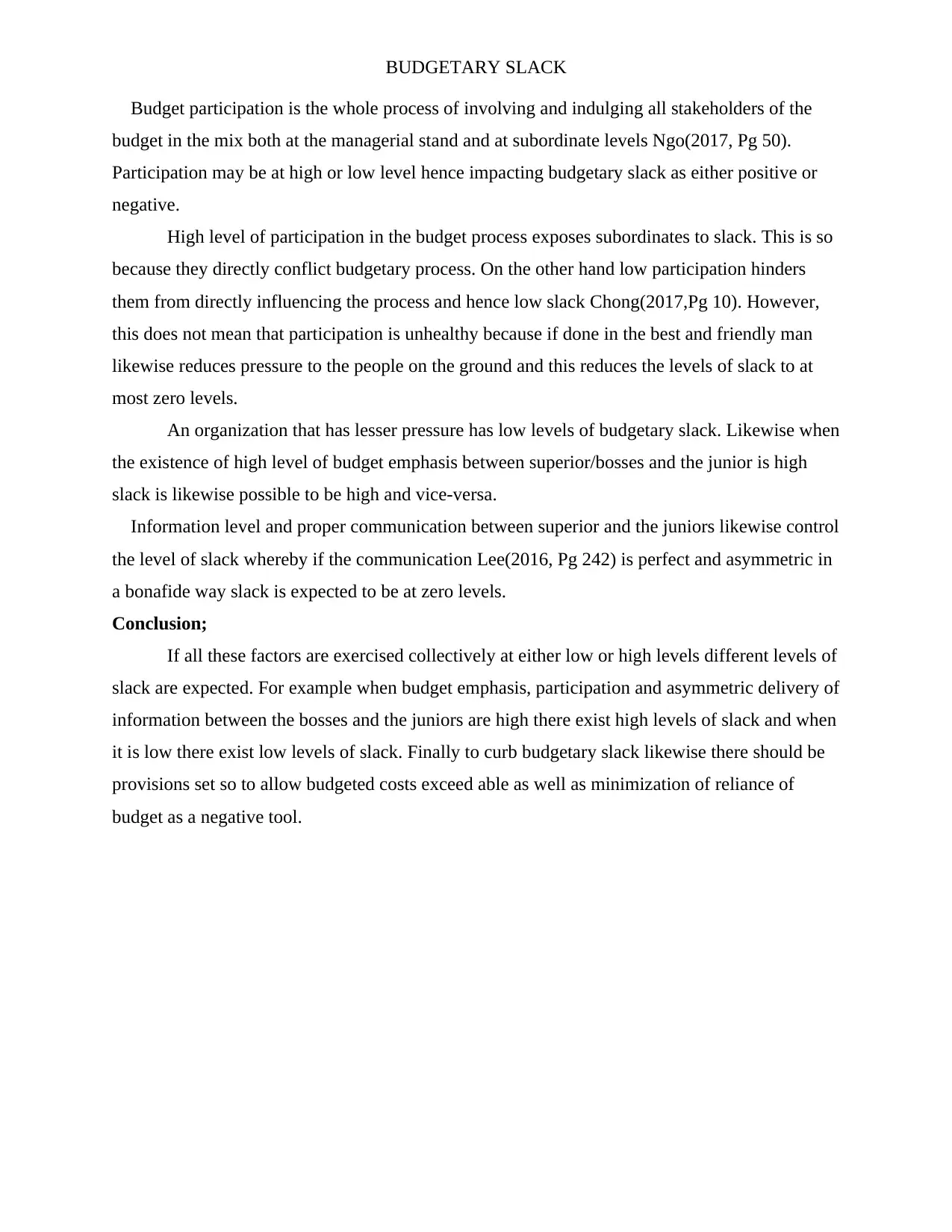
BUDGETARY SLACK
Budget participation is the whole process of involving and indulging all stakeholders of the
budget in the mix both at the managerial stand and at subordinate levels Ngo(2017, Pg 50).
Participation may be at high or low level hence impacting budgetary slack as either positive or
negative.
High level of participation in the budget process exposes subordinates to slack. This is so
because they directly conflict budgetary process. On the other hand low participation hinders
them from directly influencing the process and hence low slack Chong(2017,Pg 10). However,
this does not mean that participation is unhealthy because if done in the best and friendly man
likewise reduces pressure to the people on the ground and this reduces the levels of slack to at
most zero levels.
An organization that has lesser pressure has low levels of budgetary slack. Likewise when
the existence of high level of budget emphasis between superior/bosses and the junior is high
slack is likewise possible to be high and vice-versa.
Information level and proper communication between superior and the juniors likewise control
the level of slack whereby if the communication Lee(2016, Pg 242) is perfect and asymmetric in
a bonafide way slack is expected to be at zero levels.
Conclusion;
If all these factors are exercised collectively at either low or high levels different levels of
slack are expected. For example when budget emphasis, participation and asymmetric delivery of
information between the bosses and the juniors are high there exist high levels of slack and when
it is low there exist low levels of slack. Finally to curb budgetary slack likewise there should be
provisions set so to allow budgeted costs exceed able as well as minimization of reliance of
budget as a negative tool.
Budget participation is the whole process of involving and indulging all stakeholders of the
budget in the mix both at the managerial stand and at subordinate levels Ngo(2017, Pg 50).
Participation may be at high or low level hence impacting budgetary slack as either positive or
negative.
High level of participation in the budget process exposes subordinates to slack. This is so
because they directly conflict budgetary process. On the other hand low participation hinders
them from directly influencing the process and hence low slack Chong(2017,Pg 10). However,
this does not mean that participation is unhealthy because if done in the best and friendly man
likewise reduces pressure to the people on the ground and this reduces the levels of slack to at
most zero levels.
An organization that has lesser pressure has low levels of budgetary slack. Likewise when
the existence of high level of budget emphasis between superior/bosses and the junior is high
slack is likewise possible to be high and vice-versa.
Information level and proper communication between superior and the juniors likewise control
the level of slack whereby if the communication Lee(2016, Pg 242) is perfect and asymmetric in
a bonafide way slack is expected to be at zero levels.
Conclusion;
If all these factors are exercised collectively at either low or high levels different levels of
slack are expected. For example when budget emphasis, participation and asymmetric delivery of
information between the bosses and the juniors are high there exist high levels of slack and when
it is low there exist low levels of slack. Finally to curb budgetary slack likewise there should be
provisions set so to allow budgeted costs exceed able as well as minimization of reliance of
budget as a negative tool.
Paraphrase This Document
Need a fresh take? Get an instant paraphrase of this document with our AI Paraphraser
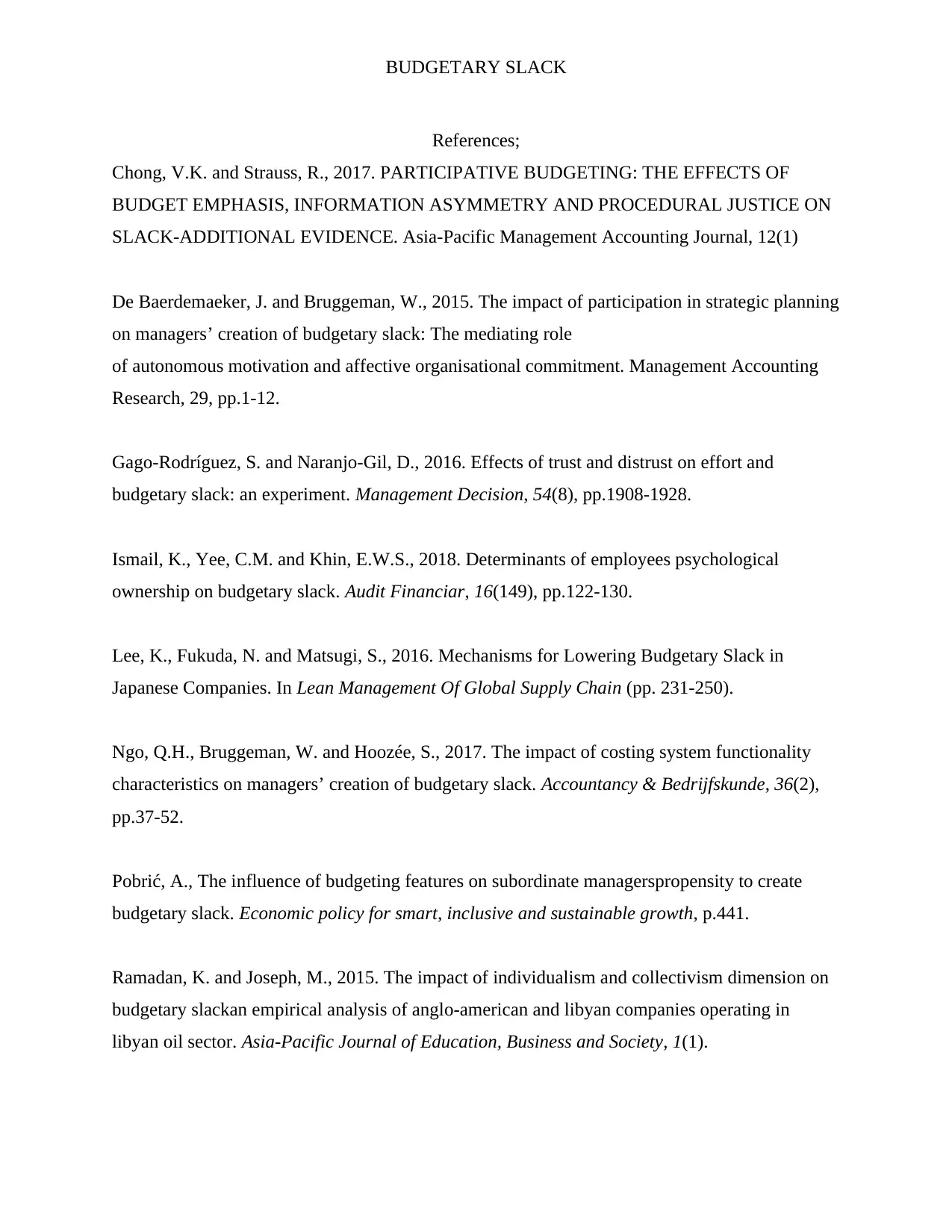
BUDGETARY SLACK
References;
Chong, V.K. and Strauss, R., 2017. PARTICIPATIVE BUDGETING: THE EFFECTS OF
BUDGET EMPHASIS, INFORMATION ASYMMETRY AND PROCEDURAL JUSTICE ON
SLACK-ADDITIONAL EVIDENCE. Asia-Pacific Management Accounting Journal, 12(1)
De Baerdemaeker, J. and Bruggeman, W., 2015. The impact of participation in strategic planning
on managers’ creation of budgetary slack: The mediating role
of autonomous motivation and affective organisational commitment. Management Accounting
Research, 29, pp.1-12.
Gago-Rodríguez, S. and Naranjo-Gil, D., 2016. Effects of trust and distrust on effort and
budgetary slack: an experiment. Management Decision, 54(8), pp.1908-1928.
Ismail, K., Yee, C.M. and Khin, E.W.S., 2018. Determinants of employees psychological
ownership on budgetary slack. Audit Financiar, 16(149), pp.122-130.
Lee, K., Fukuda, N. and Matsugi, S., 2016. Mechanisms for Lowering Budgetary Slack in
Japanese Companies. In Lean Management Of Global Supply Chain (pp. 231-250).
Ngo, Q.H., Bruggeman, W. and Hoozée, S., 2017. The impact of costing system functionality
characteristics on managers’ creation of budgetary slack. Accountancy & Bedrijfskunde, 36(2),
pp.37-52.
Pobrić, A., The influence of budgeting features on subordinate managerspropensity to create
budgetary slack. Economic policy for smart, inclusive and sustainable growth, p.441.
Ramadan, K. and Joseph, M., 2015. The impact of individualism and collectivism dimension on
budgetary slackan empirical analysis of anglo-american and libyan companies operating in
libyan oil sector. Asia-Pacific Journal of Education, Business and Society, 1(1).
References;
Chong, V.K. and Strauss, R., 2017. PARTICIPATIVE BUDGETING: THE EFFECTS OF
BUDGET EMPHASIS, INFORMATION ASYMMETRY AND PROCEDURAL JUSTICE ON
SLACK-ADDITIONAL EVIDENCE. Asia-Pacific Management Accounting Journal, 12(1)
De Baerdemaeker, J. and Bruggeman, W., 2015. The impact of participation in strategic planning
on managers’ creation of budgetary slack: The mediating role
of autonomous motivation and affective organisational commitment. Management Accounting
Research, 29, pp.1-12.
Gago-Rodríguez, S. and Naranjo-Gil, D., 2016. Effects of trust and distrust on effort and
budgetary slack: an experiment. Management Decision, 54(8), pp.1908-1928.
Ismail, K., Yee, C.M. and Khin, E.W.S., 2018. Determinants of employees psychological
ownership on budgetary slack. Audit Financiar, 16(149), pp.122-130.
Lee, K., Fukuda, N. and Matsugi, S., 2016. Mechanisms for Lowering Budgetary Slack in
Japanese Companies. In Lean Management Of Global Supply Chain (pp. 231-250).
Ngo, Q.H., Bruggeman, W. and Hoozée, S., 2017. The impact of costing system functionality
characteristics on managers’ creation of budgetary slack. Accountancy & Bedrijfskunde, 36(2),
pp.37-52.
Pobrić, A., The influence of budgeting features on subordinate managerspropensity to create
budgetary slack. Economic policy for smart, inclusive and sustainable growth, p.441.
Ramadan, K. and Joseph, M., 2015. The impact of individualism and collectivism dimension on
budgetary slackan empirical analysis of anglo-american and libyan companies operating in
libyan oil sector. Asia-Pacific Journal of Education, Business and Society, 1(1).
1 out of 5
Your All-in-One AI-Powered Toolkit for Academic Success.
+13062052269
info@desklib.com
Available 24*7 on WhatsApp / Email
![[object Object]](/_next/static/media/star-bottom.7253800d.svg)
Unlock your academic potential
Copyright © 2020–2025 A2Z Services. All Rights Reserved. Developed and managed by ZUCOL.


